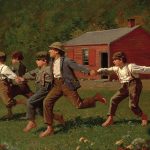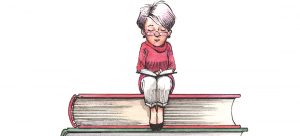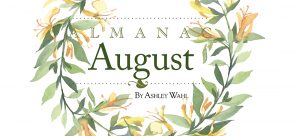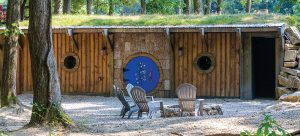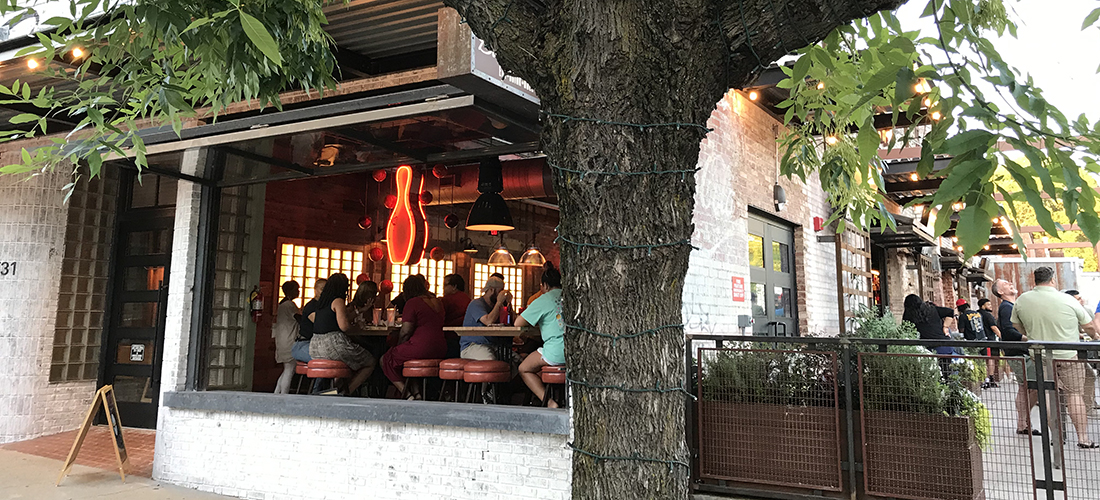
Tippling and Tenpin
And a trip down memory lanes
By Billy Eye
One of the advantages bowling has over golf is that you seldom lose a bowling ball. — Don Carter
Downtown’s newest entertainment destination combines two of my favorite pastimes — bourbon and bowling. One of which Eye indulge in daily, the other . . . not so much. But that’s likely to change.
For decades, the corner of South Elm and Lewis Street was the site of a very Sanford-like junk shop, a veritable island of misfit washers and dryers, where doorless refrigerators went to die. You won’t believe that was ever true when you check out downtown’s latest sensation: Bourbon Bowl where, on opening weekend, so many alky lovin’ alley cats jammed the place that it was forced to close for restocking.
Nationwide, bowling began catching on in the 1800s but didn’t migrate as far as our fair city until the mid-1930s, when Greensboro Bowling Center debuted in the 300 block of North Elm. This was back in the days when “pinboys,” one to a lane, stood at the ready to manually reset the 10 plastic coated Maplewood pins after every frame, then roll balls back up the gutter. Hardly a coincidence that bowling came to Greensboro a year after the state allowed for the sale of beer in public after an almost 30-year prohibition. Within a few years, Downtown Bowling Alley at 111 East Washington Street opened for “duck pin” competition (a slight variation on the game preferred by many). It was located behind where Thousands of Prints presently stands.
Charging just a quarter per game, these two venues catered to a decidedly blue-collar clientele where, every week, competition between local bowling leagues reigned. Employees at Sears, Roebuck and Co., for instance, would square off against competitors from Guilford National Bank, or Rustin Furniture builders would go head-to-head with Bocock-Stroud’s clothiers.
In the mid-1950s, pinboys became one of the many professions to be rendered obsolete by automation with the introduction of AMF’s automatic pinspotters. By that time, bowling had earned a somewhat seedy reputation. After 25 years, our alleys had declined into smoke-filled caverns; burgers sizzling on flat-top grills while hot dogs rolled for hours on end before some cigar-chomping dipsomaniac stuffed them into soggy buns before plopped them onto white, waxed paper reeking of nicotine.
In the ’60s and ’70s, thanks in part to televised matches broadcast on weekend afternoons, bowling attained nationwide fad status, further ignited by Boomer families looking for wholesome entertainment. To fill that void, modern, streamlined facilities were introduced in Greensboro, beginning in 1959. You may recall Fair Lanes Friendly Bowlarama (later Brunswick Triad Lanes) located at the northeastern edge of a newly opened Friendly Shopping Center. Or O Henry Lanes on East Bessemer, next to the slot car races and Monroe’s Drive-In. And don’t forget Coliseum Fair Lanes on High Point Road. In the ’70s, with some 52 million Americans participating, bowling became the number one participatory sport in the nation. That’s when the sprawling Piedmont Bowling Lanes moved to their current location on Holden Road, with 40 wide lanes, a nursery and a pristine snack shop.
In the mid-70s, I frequented Brunswick Triad Lanes at Friendly primarily to finger their wall of pinball machines. I was struck by the Atomic Age design of the bowling alley itself, complete with stainless steel accents and multi-colored, molded plastic chairs from its 1959 Bowlarama days still in use. After three decades, Brunswick Triad Lanes moved to Oak Branch Drive off Wendover. There, management subsequently installed disco bumper cars, a Lebowski-like lounge and an ungodly retro-candy shop stocked with tooth-rotters you haven’t run across since high school.
Bourbon Bowl’s six lanes may seem a bit claustrophobic compared to AMF All Star Lanes or Triad Lanes (both still going strong) but, then again, I’m not convinced the competitive-sporting aspect of this establishment was meant to be the star attraction.
A joint whose name contains the word “bourbon” should stock a wide array of distilled mash, right?
“We have pretty much everything,” confirms Bourbon Bowl’s bar manager, Travis Tindall. “Irish whiskey, special Japanese whiskies, name brands like Rabbit Hole, Glenlivet, Macallan-aged-18-year scotch, Van Winkle, Hendricks, Blanton’s and Lonerider, a North Carolina blend.” Serious about their whiskies, BB offers 125 brands and will have added another 110 bottles by the time you read this. “Some of the rarer whiskeys that we can find, that we can get ahold of, we plan to get,” Tindall says.
The bar, said to be the longest in the city, allows patrons to imbibe indoors or outside while lounging on its enormous patio while enjoying waterfalls framed in rusted metal, distressed brickwork and random industrial accoutrements. The menu, to be expanded later, includes finger food stalwarts like tacos, shrimp skewers, burgers, salads, wraps, dips and an array of, yes, fried cheeses, some with interesting culinary twists.
Lanes rent for $40 an hour, plus a few bucks for shoe rental. On every occasion I’ve wandered by, Bourbon Bowl has been packed, appealing to families around the dinner hour when even small children can join in the games with the help of bowling ramps and bumpers to ensure at least a few of your tot’s pins will be knocked over. Starting around 10 p.m., young professionals begin congregating around the bar.
“The crowd is ravenous,” Tindall tells me. “Whenever a business nearby lets out for the night, service workers and customers roll in here in waves.”
And with such potent potables as the Moscow Mule, the Manhattan or, perhaps, a Smoked Old Fashioned, it’s little wonder.
“The orange zest soaks up the mahogany and cherry wood flavor and adds a different level of intensity,” says Tindall of their Smoked Old Fashioned. “You can smell it all throughout the restaurant.”
The staff is populated with pros who’ve served for years at other local hotspots. “This is probably the most talented group of bartenders I’ve ever known,” Tindall says. “I’ve been from here to Philadelphia, and these guys have forgotten more about bartending than most people learn in their entire lifetime.”
Not your Old Grand-Dad’s experience, but they do have a bottle of that behind the bar. OH
Billy Eye comes from a long line of discerning bourbon drinkers.
His favorite children’s book, In The Night Kitchen, Maurice Sendak’s tribute to Winsor McCay, does not contain a single mention of alcohol.


